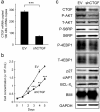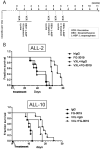Targeting connective tissue growth factor (CTGF) in acute lymphoblastic leukemia preclinical models: anti-CTGF monoclonal antibody attenuates leukemia growth
- PMID: 24154679
- PMCID: PMC3948212
- DOI: 10.1007/s00277-013-1939-2
Targeting connective tissue growth factor (CTGF) in acute lymphoblastic leukemia preclinical models: anti-CTGF monoclonal antibody attenuates leukemia growth
Abstract
Connective tissue growth factor (CTGF/CCN2) is involved in extracellular matrix production, tumor cell proliferation, adhesion, migration, and metastasis. Recent studies have shown that CTGF expression is elevated in precursor B-acute lymphoblastic leukemia (ALL) and that increased expression of CTGF is associated with inferior outcome in B-ALL. In this study, we characterized the functional role and downstream signaling pathways of CTGF in ALL cells. First, we utilized lentiviral shRNA to knockdown CTGF in RS4;11 and REH ALL cells expressing high levels of CTGF mRNA. Silencing of CTGF resulted in significant suppression of leukemia cell growth compared to control vector, which was associated with AKT/mTOR inactivation and increased levels of cyclin-dependent kinase inhibitor p27. CTGF knockdown sensitized ALL cells to vincristine and methotrexate. Treatment with an anti-CTGF monoclonal antibody, FG-3019, significantly prolonged survival of mice injected with primary xenograft B-ALL cells when co-treated with conventional chemotherapy (vincristine, L-asparaginase and dexamethasone). Data suggest that CTGF represents a targetable molecular aberration in B-ALL, and blocking CTGF signaling in conjunction with administration of chemotherapy may represent a novel therapeutic approach for ALL patients.
Figures




Similar articles
-
Connective tissue growth factor as a novel therapeutic target in high grade serous ovarian cancer.Oncotarget. 2015 Dec 29;6(42):44551-62. doi: 10.18632/oncotarget.6082. Oncotarget. 2015. PMID: 26575166 Free PMC article.
-
Targeting CTGF in Cancer: An Emerging Therapeutic Opportunity.Trends Cancer. 2021 Jun;7(6):511-524. doi: 10.1016/j.trecan.2020.12.001. Epub 2020 Dec 25. Trends Cancer. 2021. PMID: 33358571 Review.
-
Anti-connective tissue growth factor (CTGF/CCN2) monoclonal antibody attenuates skin fibrosis in mice models of systemic sclerosis.Arthritis Res Ther. 2017 Jun 13;19(1):134. doi: 10.1186/s13075-017-1356-3. Arthritis Res Ther. 2017. PMID: 28610597 Free PMC article.
-
Connective tissue growth factor-specific antibody attenuates tumor growth, metastasis, and angiogenesis in an orthotopic mouse model of pancreatic cancer.Mol Cancer Ther. 2006 May;5(5):1108-16. doi: 10.1158/1535-7163.MCT-05-0516. Mol Cancer Ther. 2006. PMID: 16731742
-
Targeting PI3K Signaling in Acute Lymphoblastic Leukemia.Int J Mol Sci. 2019 Jan 18;20(2):412. doi: 10.3390/ijms20020412. Int J Mol Sci. 2019. PMID: 30669372 Free PMC article. Review.
Cited by
-
The role of CCN family genes in haematological malignancies.J Cell Commun Signal. 2015 Sep;9(3):267-78. doi: 10.1007/s12079-015-0296-4. Epub 2015 May 31. J Cell Commun Signal. 2015. PMID: 26026820 Free PMC article.
-
Kidney Fibrosis: Origins and Interventions.Transplantation. 2017 Apr;101(4):713-726. doi: 10.1097/TP.0000000000001608. Transplantation. 2017. PMID: 27941433 Free PMC article. Review.
-
CTGF increases matrix metalloproteinases expression and subsequently promotes tumor metastasis in human osteosarcoma through down-regulating miR-519d.Oncotarget. 2014 Jun 15;5(11):3800-12. doi: 10.18632/oncotarget.1998. Oncotarget. 2014. PMID: 25003330 Free PMC article.
-
Location First: Targeting Acute Myeloid Leukemia Within Its Niche.J Clin Med. 2020 May 18;9(5):1513. doi: 10.3390/jcm9051513. J Clin Med. 2020. PMID: 32443460 Free PMC article. Review.
-
Eviction from the sanctuary: Development of targeted therapy against cell adhesion molecules in acute lymphoblastic leukemia.Semin Oncol. 2017 Apr;44(2):101-112. doi: 10.1053/j.seminoncol.2017.06.005. Epub 2017 Jul 11. Semin Oncol. 2017. PMID: 28923207 Free PMC article. Review.
References
-
- Leask A, Abraham DJ. All in the CCN family: essential matricellular signaling modulators emerge from the bunker. J Cell Sci. 2006;119(Pt 23):4803–10. - PubMed
-
- Dhar A, Ray A. The CCN family proteins in carcinogenesis. Exp Oncol. 2010;32(1):2–9. - PubMed
-
- Kang Y, Siegel PM, Shu W, Drobnjak M, Kakonen SM, Cordón-Cardo C, et al. A multigenic program mediating breast cancer metastasis to bone. Cancer Cell. 2003;3(6):537–49. - PubMed
-
- Xie D, Yin D, Wang HJ, Liu GT, Elashoff R, Black K, et al. Levels of expression of CYR61 and CTGF are prognostic for tumor progression and survival of individuals with gliomas. Clin Cancer Res. 2004;10(6):2072–81. - PubMed
Publication types
MeSH terms
Substances
Grants and funding
LinkOut - more resources
Full Text Sources
Other Literature Sources
Miscellaneous

